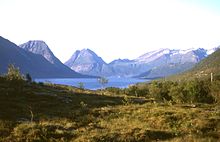- Danish straits
-
Not to be confused with Denmark Strait.
The Danish straits are the three channels connecting the Baltic Sea to the North Sea through the Kattegat and Skagerrak. They transect Denmark, and are not to be confused with the Denmark Strait between Greenland and Iceland. The three main passages are:
- Great Belt, Danish: Storebælt
- Little Belt, Danish: Lillebælt
- Oresund, Danish: Øresund (Swedish: Öresund)
By closer view there are five straits named belt (Danish: Bælt), the only ones in the world and several straits named sound (Danish, Swedish and German: sund). Where an island is situated between a belt and a sound, typically the broader strait is called belt and the more narrow one is the sound:
- Als:
- separated from the continent by Alssund
- separated from Fyn the southern part of the Little Belt, an area referred to in German (but not Danish) as Alsenbelt
- Langeland:
- separated from Tåsinge Island by Siø Sund (Tåsinge itself is separated from Fyn by Svendborg Sund)
- separated from Lolland by Langelandsbælt, the southern part of Great Belt
- Lolland:
- separated from Falster Island by Guldborgsund (Falster itself is separated from Zealand by Storstrømmen Strait)
- separated from Langeland by Langelandsbælt
- separated from Fehmarn by Femernbælt, which is the common continuation of Great Belt–Langelandsbælt and Little Belt
- Zealand (Danish: Sjælland)
- separated from Scandinavia Peninsula of the continent by Øresund (Danish) / Öresund (Swedish)
- separated from Fyn Island by the Great Belt
Etymology and general use of Sound / Sund
 The Aldersund in Helgeland in northern Norway divides Aldra Island (left hand) from the continent
The Aldersund in Helgeland in northern Norway divides Aldra Island (left hand) from the continent
The Germanic word "sound" has the same root as the verb "to sunder" in the meaning of to separate. In Swedish language any strait is called "Sund". In Norway hundreds of narrow straits separating islands and combining Fjords or outer parts of Fjords are named "Sund". Another explanation derives Sound from an ancient verb "sund" in the meaning of to swim. That way a sound is a swimmable strait.
With the denomination of fjords and other bays in North America (Prince William Sound) and New Zealand the European meaning of the word has been lost.
The Germanic word "sound" is not related to the Romance originated word "sound", which has developed from the Latin sonus.
See also
Categories:- Straits of Denmark
- Baltic Sea
- North Sea
- International straits
Wikimedia Foundation. 2010.


